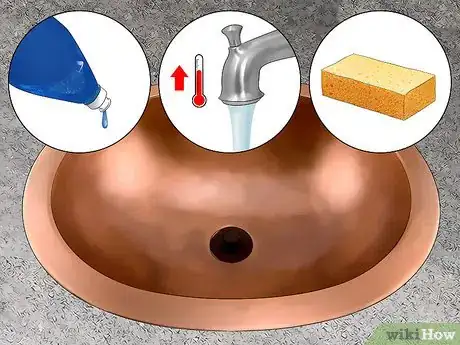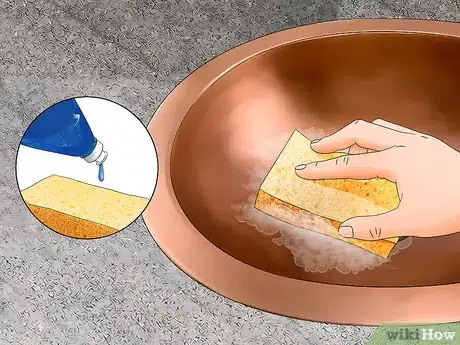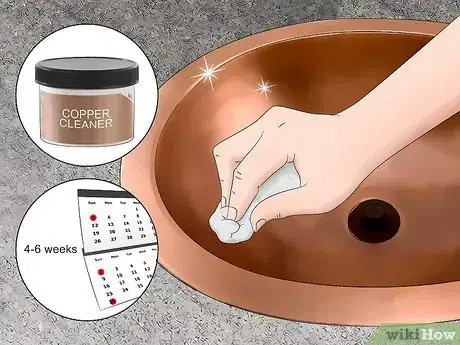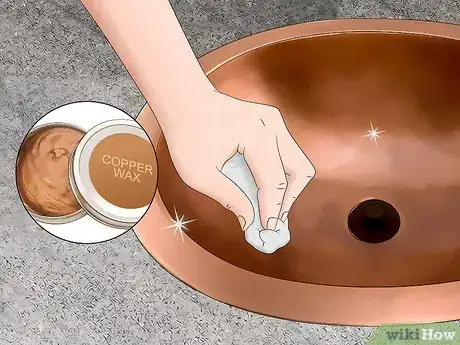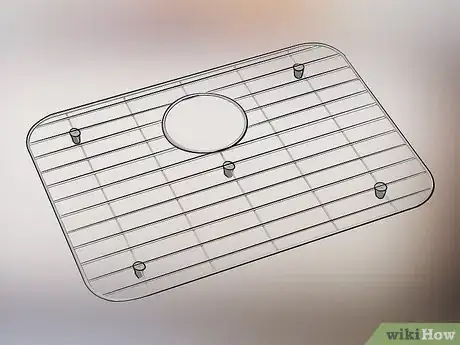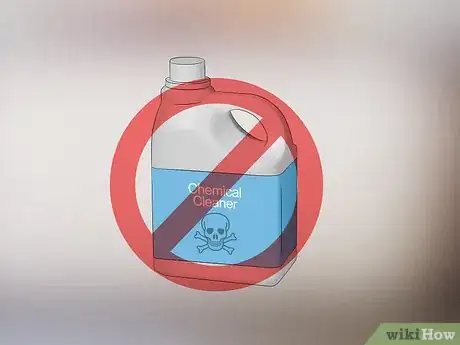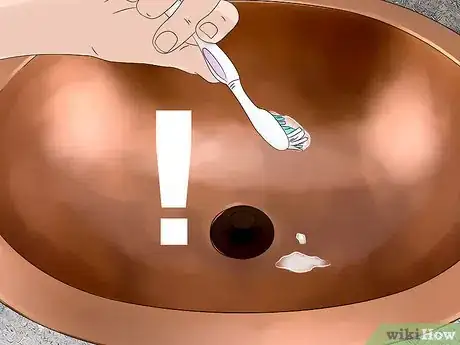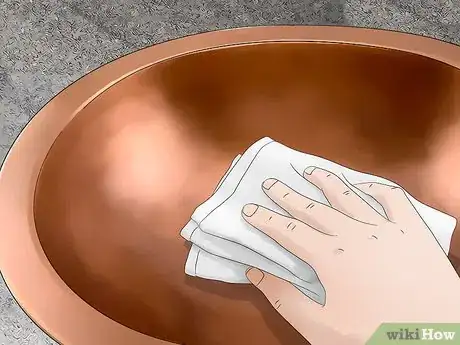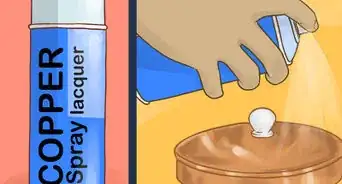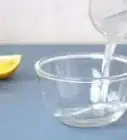This article was co-authored by Elias Weston. Elias Weston is a Cleaning Specialist and the Founder of Seatown Cleaners in Seattle, Washington. Elias specializes in helping clients find cleaning services with instant booking and flexible pricing. Seatown Cleaners offers standard, deep, and move-in/out cleaning services using green products and cleaning techniques. Every cleaner is thoroughly vetted and every cleaning is backed by a 100% money-back guarantee.
There are 7 references cited in this article, which can be found at the bottom of the page.
This article has been viewed 68,936 times.
A copper sink adds a gorgeous focal point to any kitchen or bathroom. Whether you want to preserve a polished look or love a natural patina, a little routine maintenance will keep your sink in the best condition. All copper sinks should be washed with warm water, mild dish soap, and a soft sponge. Dry your sink after cleaning or using it to prevent mineral deposits and green spotting. If you want to keep your polished sink shiny, apply a copper cleaner and wax at least every six weeks. To maintain both polished surfaces and those with a patina, avoid harsh cleaners and abrasive scrubbing pads.
Steps
Using Dish Soap and Water for Routine Cleanings
-
1Use a mild dish soap and a soft sponge to clean your sink. Dish soap, warm running water, and a soft sponge are all you'll need for regular cleanings. Basic, routine cleaning is the same for all copper sinks, whether your sink is vintage, hammered, raw, or polished.
- Use only a soft, non-abrasive sponge or cloth. Don't use harsh scrubbers, such as steel wool.
-
2Wipe all sides of the sink with the soapy sponge. Run warm water from the faucet and use the sprayer to wet the sink. Squirt one or two drops of the dish soap onto the wet sponge. Wipe down the sink with the soapy sponge from top to bottom on all sides.[1]
- You should clean your sink daily to keep it in the best shape.
Advertisement -
3Rinse and towel dry the sink after cleaning it. Use the sprayer to rinse away soap suds with warm water. After thoroughly rinsing the sink, dry it with a clean towel.[2]
- Drying the sink will prevent the formation of mineral deposits and green spotting.
-
4Use a baking soda paste for stubborn stains. To remove a stubborn mark or stain, apply baking soda to a cloth and, with warm water running, gently scrub the affected area.[3]
- If your sink is shiny and polished or finished, you can add vinegar to the baking soda to remove stains and polish the sink. Mix ¼ cup of baking soda and ¼ cup of vinegar into a paste. Using a microfiber cloth, apply the paste and buff the copper. Rinse with warm water and dry with a clean cloth.
- Instead of vinegar, you can use lemon juice that is also acidic and has the same effect.
- However, if your sink is vintage or you want to preserve a patina, avoid using vinegar or lemon juice.
Maintaining a Bright, Polished Look
-
1Clean your sink with a copper cleaner every four to six weeks. If your copper sink is polished or finished and you want to maintain its shine, you should use a copper cleaner at least every six weeks. Apply the cleaner to a cloth, wipe all surfaces, then rinse and dry the sink. Check your copper cleaner's instructions for more specific information about how to use it.
- Copper is a living surface that develops a patina over time, but a copper cleaner can help slow the development of patina and preserve a polished look.[4]
- Don't use a copper cleaner on a vintage sink or if you want your sink to develop a patina.
-
2Apply a copper protectant or wax to keep your copper shiny. Using a copper protectant or wax after cleaning and drying your sink will also help preserve its bright, polished look. Depending on your product's application method, spray it onto the sink or apply it with a cloth. Then use a microfiber towel to buff all of the sink's surfaces.[5]
- Apply a copper wax or protectant every six weeks or whenever water no longer beads on its surface.
- Aside from products specially labelled for copper, you can also buff your sink with carnauba wax to preserve its brilliance.[6]
-
3Use a sink grid or mat when washing dishes. If your copper sink is hammered or has a patina, there's no need to worry about dings or dents from washing dishes, pots, and pans. However, to preserve a polished sink's shine, you'll want to avoid direct contact between your sink and dishware. Place a sink grid or mat down when you wash dishware, and dry wares in a countertop drying rack.[7]
Caring for a Copper Sink
-
1Avoid using harsh chemicals or abrasive scrubbers. The most important aspect of copper sink care is to steer clear of harsh chemicals and abrasive cleaners or scrubbers. Don't use bleach, lime or rust removers, or ammonia-based cleaners in or around your sink. Stay away from abrasive powdered cleaners like Comet.[8]
- Never use scouring pads, steel wool, or any other hard scrubbing pad.
-
2Avoid letting acidic foods or toothpaste sit in a copper sink. Acidic foods and liquids are harmful to all copper surfaces. Don't let things like tomato sauce or lemon juice sit in your sink, and keep the water running when dealing with any acidic items.[9]
- Toothpaste can also discolor copper, so rinse away toothpaste residue after brushing if your bathroom sink is copper.
-
3Avoid leaving pots and pans in your sink for too long. Putting cookware away as soon as possible will keep any copper sink in the best condition, whether vintage or polished. Dirty pots and pans might contain acidic ingredients that can discolor both patina and polish.[10]
- Pots and pans left to dry in the sink can shift positions and potentially leave a dent in a shiny copper surface.
-
4Dry your sink after each use to prevent hard water deposits. If you have hard water, it's especially important to dry your sink every time you use it. Mineral deposits can be unsightly on both polished copper and surfaces with a patina.[11]
- The most accurate ways to determine if you have hard water are to ask your water company or to use a home test kit. You can purchase a kit online or at a store that sells pools, or you can contact a water softener company and ask if they offer free tests.
Expert Q&A
-
QuestionCan you use vinegar on copper sinks?
 James SearsJames Sears leads the customer happiness team at Neatly, a group of cleaning gurus based in Los Angeles and Orange County, California. James and the team have nine years of experience and offer green cleaning, interior and exterior window washing, and general apartment cleaning services. He provides transformative cleaning experiences by reducing clutter and renewing your home environment. James is a Trustee Scholar at the University of Southern California.
James SearsJames Sears leads the customer happiness team at Neatly, a group of cleaning gurus based in Los Angeles and Orange County, California. James and the team have nine years of experience and offer green cleaning, interior and exterior window washing, and general apartment cleaning services. He provides transformative cleaning experiences by reducing clutter and renewing your home environment. James is a Trustee Scholar at the University of Southern California.
House Cleaning Professional Yes, you can use regular or apple cider vinegar, as you prefer. Just remember that copper is a soft metal, so don't use anything abrasive to clean it. Wipe it down with a soft sponge or a microfiber cloth.
Yes, you can use regular or apple cider vinegar, as you prefer. Just remember that copper is a soft metal, so don't use anything abrasive to clean it. Wipe it down with a soft sponge or a microfiber cloth. -
QuestionCan a chamois be used to safely dry copper sinks?
 Community AnswerYes.
Community AnswerYes.
References
- ↑ https://www.youtube.com/watch?v=8QQeTfXOiX4&feature=youtu.be&t=27
- ↑ https://www.youtube.com/watch?v=8QQeTfXOiX4&feature=youtu.be&t=31
- ↑ https://www.plumbingsupply.com/best-ways-to-care-for-copper-sinks.html
- ↑ https://www.plumbingsupply.com/best-ways-to-care-for-copper-sinks.html
- ↑ http://www.homeadvisor.com/r/copper-kitchen-sinks/
- ↑ https://www.plumbingsupply.com/best-ways-to-care-for-copper-sinks.html
- ↑ https://www.plumbingsupply.com/best-ways-to-care-for-copper-sinks.html
- ↑ https://www.youtube.com/watch?v=8QQeTfXOiX4&feature=youtu.be&t=40
- ↑ https://www.youtube.com/watch?v=8QQeTfXOiX4&feature=youtu.be&t=55
About This Article
To clean a copper sink, start by wiping it down with soapy water and a soft sponge. Then, scrub any stubborn stains with a damp cloth and some baking soda. When you're finished, rinse your sink with water, and dry it off with a towel so green spots don't form. To keep your copper sink looking shiny and new, clean it with a copper cleaner every 4-6 weeks. For more tips on how to take care of a copper sink, scroll down!
